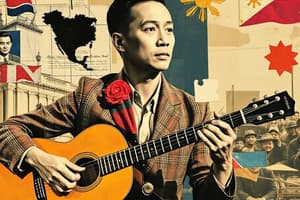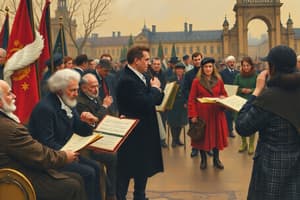Podcast
Questions and Answers
Composers during the Romantic Period often incorporated what element into their music to express nationalism?
Composers during the Romantic Period often incorporated what element into their music to express nationalism?
- Complex polyphonic textures
- Twelve-tone techniques
- Ancient Greek modes
- Folk Songs (correct)
How did the audience's role in musical performances evolve during the Romantic Period compared to previous eras?
How did the audience's role in musical performances evolve during the Romantic Period compared to previous eras?
- Audiences were mainly critics, providing analytical reviews of the performances.
- Audiences were actively engaged participants, showing emotions freely. (correct)
- Audiences were excluded from performances, which were primarily for the aristocracy.
- Audiences became passive listeners, valuing technical perfection above all else.
Which artistic principle, fundamental to Neoclassicism, aimed to create harmony and balance in artworks?
Which artistic principle, fundamental to Neoclassicism, aimed to create harmony and balance in artworks?
- Proportion (correct)
- Asymmetry
- Abstraction
- Exaggeration
How does engaging in festival dances contribute to overall physical fitness?
How does engaging in festival dances contribute to overall physical fitness?
In first aid, what is the immediate priority when approaching an emergency scene?
In first aid, what is the immediate priority when approaching an emergency scene?
Which of the following best describes the focus of Romantic art?
Which of the following best describes the focus of Romantic art?
What is a key characteristic that distinguishes Romantic instrumentation from previous musical periods?
What is a key characteristic that distinguishes Romantic instrumentation from previous musical periods?
Which of the following scenarios requires the application of cravat phase bandaging?
Which of the following scenarios requires the application of cravat phase bandaging?
Flashcards
Nationalism in Music
Nationalism in Music
Composers incorporated folk songs into their works for national pride.
Romantic Period
Romantic Period
An era focused on emotion, imagination, and freedom of expression in music (1820-1900).
Frederick Chopin
Frederick Chopin
Known as the 'Poet of the Piano' for his expressive piano compositions.
Neoclassicism
Neoclassicism
Signup and view all the flashcards
Festival Dance
Festival Dance
Signup and view all the flashcards
First Aid
First Aid
Signup and view all the flashcards
Wound Management
Wound Management
Signup and view all the flashcards
Heart Attack
Heart Attack
Signup and view all the flashcards
Study Notes
MUSIC
- Nationalism in Music: Composers incorporated folk songs to express national pride.
- Romantic Period (1820-1900): Focused on emotion, imagination, and expressive freedom.
- Romantic Period Audience: Active participation in musical performances.
- Frederick Chopin: Known as the "Poet of the Piano" for expressive compositions.
- Romanticism's Artistic Freedom: Encouraged unrestricted creativity.
- Musical Heritage's Contribution: Influenced modern creativity.
- Franz Liszt: A highly skilled and influential virtuoso pianist of the Romantic Era.
- Prelude: A short musical piece, possibly introductory or independent.
- Romantic Instrumentation: Employed rich and thick sounds for emotional expression.
- "Lupang Hinirang" and Romanticism: Expresses deep emotion and nationalistic sentiments.
ARTS
- "Classicus": Latin for "first class," basis for Neoclassicism.
- Neoclassicism and Romanticism: Art styles from late 18th to mid-19th centuries.
- Romantic Art Focus: Emphasized individual emotion and imagination over strict forms.
- Romantic Art Functions: Expressed individuality and deep emotions.
- Neoclassical Art Principle: Used proportion to create harmony and balance.
- Romantic Art Characteristics: Grandeur, drama, and emotional intensity.
- Juan Luna: Famous Filipino artist known for "Spoliarium".
- Neoclassicism's Rejection of Rococo: Originated in the mid-18th century.
PHYSICAL EDUCATION
- Festival Dance: Community dances honoring patrons or celebrating harvests.
- Aliwan Fiesta: Gathering and competition of Philippine festivals.
- Religious Festivals: Examples are Ati-Atihan, Sinulog, and Dinagyang.
- Festival Dancing Benefits: Improves cardiovascular health and teamwork.
- Basic Locomotor Movement: Walking is fundamental.
- Activity Intensity: Heavy intensity causes shortness of breath.
- Dancing and Weight Control: Burns calories based on intensity.
- Sedentary Lifestyle Effects: Leads to heart disease, diabetes, and obesity.
- Range of Movement: Refers to scope of motion.
- Bleking Step: Step right, heel left in front.
HEALTH
- First Aid: Immediate care before professional help arrives.
- Emergency First Step: Survey the scene before acting.
- Wound: A break in the skin or tissue.
- Bleeding Control: Use direct pressure.
- Bandaging: Protecting wounds with materials.
- Bandaging Techniques: Cravat phase for head, chest, hands, and arms.
- Fitness in First Aid: Rescuers need endurance, strength, and power.
- Victim Transport: Blanket drag is easiest method.
- Fireman's Carry: For unconscious or small victims.
- Heart Attack: Sudden blood flow blockage to the heart.
- Heat Exhaustion: Move victim to a cool place immediately.
- Emergency Procedures: Call for help before assisting injured people.
Studying That Suits You
Use AI to generate personalized quizzes and flashcards to suit your learning preferences.




